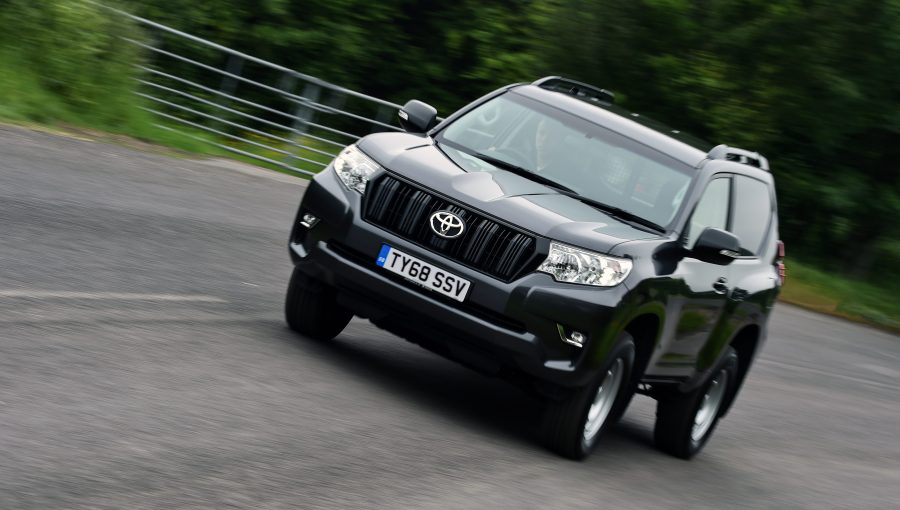Although Toyota’s passenger car range is predominantly focused around petrol-electric hybrid powertrains, the Land Cruiser, Hilux and Proace models are fitted with diesel engines. A diesel particulate filter (DPF) is a feature of these models, and you may have heard about the need for regular DPF regeneration. What does this component do and how do you take care of it?
What does a diesel particulate filter (DPF) do?
The DPF is fitted within the exhaust system and is designed to catch soot particles and nitrous oxide (NOx) from the combustion process that would otherwise be released into the atmosphere. The DPF is highly effective and traps around 80% of these harmful particulates.

Why do modern diesel engines need a DPF?
European legislation places strict exhaust emissions targets on all vehicle manufacturers. From September 2009, the Euro 5 legislative standard came into effect, part of which required all diesel cars registered from that point on to be equipped with a diesel particulate filter, or DPF.
These filters are used throughout the industry in all diesel-powered passenger vehicles, and their efficiency is vital now that stringent Euro 6d emissions standards are in force.
Do I need to replace a DPF during normal servicing?
Diesel particulate filters do have a capacity limit and can become full. But unlike traditional air, oil or pollen filters that need to be exchanged manually at regular intervals, the DPF has a much longer service life and is designed to regenerate to restore its performance.
The car’s electronic control unit (ECU) is programmed to do this automatically, neutralising the soot by burning it off at high temperature within the exhaust system while the vehicle is running. All modern cars with diesel engines follow this procedure.

How does DPF regeneration occur?
The regeneration occurs automatically, usually without the driver being aware that it is taking place. In the majority of cases, the process is carried out when the engine and exhaust system has reached normal operating temperature and the vehicle is travelling at over 40mph.
However, if your driving is limited to urban areas, the low speeds and frequent stops mean the conditions for normal regeneration do not exist. In these instances, the ECU monitors the accumulation of soot and instructs an alternative regeneration programme to begin well before the filter becomes saturated.
This programme injects small quantities of fuel into the engine after combustion, which increases the temperature within the exhaust system and creates an environment where it is possible to safely burn off the soot.
This method is very successful within the small percentage of vehicles where normal regeneration is not possible. However, due to the nature of city traffic, the regeneration process can be interrupted when the vehicle completes its short journey and is turned off. If this occurs, the ECU is programmed to recommence the process when the engine is restarted and back up to temperature again.

How can I help prevent DPF blockages in my Toyota?
Follow these four simple actions:
1. Regularly drive your Toyota on highways at speeds of between 40-55mph for around 20-30 minutes.
2. Avoid spending unnecessary amounts of time with the engine idling.
3, Try to limit the frequency of short journeys where the engine is running for less than ten minutes.
4. Do not ignore dashboard alerts related to the DPF.
Will I be warned if all DPF regeneration processes have been unsuccessful?
Very occasionally, use of the vehicle might be such that it will have been impossible for the ECU to complete the administration of any regeneration procedure. At this point, the DPF will have become overloaded and stopped functioning, so your Toyota will illuminate a warning light in the dashboard. It will then be necessary for the soot to be neutralised and the filter regenerated manually at a main dealer.
It is extremely unwise to ignore this visual warning as the DPF can become irreparably damaged. What’s more, it is illegal to remove the filter entirely.
Learn more: What is the exhaust gas recirculation valve and what does it do?





Hi I am omkar
I drive Toyota innova 2.5 2010
So does it contain DPF system
Hi Omkar,
Thanks for your post. Unfortunately, due to this model not being in the UK range we are unable to check whether this car has DPF. We would advise contacting Toyota from the country you are based in. Hope this helps!
Hi i have a 2010 T4 AVENSIS it shoots big massive puff of smokes time to time, like smokes come and disappear. i took the car to local garage and mechanic said its a dpf causing this trouble. Any help please specially some1 with similar situation many thanks
Hi Syed,
Have you taken it to a Toyota dealer?
No i havent yet but i will soon
Hi Syed,
Thanks for getting back to us. We would say this is the best option, your local dealer with give the best support and advice!
Hi I have an Avensis 2009 2.2 d tr (the newer shape) chassis sb1ba76l70e004005, 81000 miles and have noticed a rattle from the steering column at low speeds which is very annoying and have been told that the steering shaft splines may be worn and should have been fixed as part of a recall but cant seem to find any confirmation on this. Also I have noticed clouds of smoke occasionally being emitted from the exhaust, any advice please.
Hi there,
Thanks for your post. We have replied to one of your later posts! 🙂
Hi Ella, thanks for getting back, can you tell me how to access your response ?
Hi there,
Your response should be on the other comment that you posted. Many thanks!
Very interesting!
We purchased a new Yaris Icon in 2014 and the DPF has given trouble and continues to give trouble. If you are considering purchasing one of these cars DONT! (DPF is only one issue)
Toyota absolutely refuse to help under warranty.
Feel free to publish my email address and I will tell my story HONESTLY to any one who cares to listen.
My FIRST AND LAST Toyota
Richard McNabb N Ireland
Hi Richard,
We’re so sorry to hear you’re having trouble with your car! Did you speak to customer relations about your bad experience?
Thank you Ella for posting my two comments! We have received a number of telephone questionnaires during our 2 years of Toyota ownership. In all of these we have given honest responses but didn’t receive any solid answers to our queries.
I can only assume these calls came from Toyota “customer relations” dept? Perhaps not!
R
Hi Richard,
That’s no problem. Was it a dealer or customer relations you spoke to regarding your DPF? Do you have a case number from customer relations?
The car has been with a Toyota dealer.
Hi Richard,
Thanks for getting back to us. We would have to advise logging this problem with out customer relations team! They will be able to escalate this further- you can get in touch with them via telephone: 0344 701 6202 OR via our email form: https://www.toyota.co.uk/contact-us/email-us! Please let us know if you have any more questions 🙂
Very interesting reading about DPF etc
Also interesting that my previous post was removed
Sad that Toyota cannot be honest enough to leave a post containing a real life story about a real car purchased from a real Toyota dealership
Sad also that Toyota refuse to repair a PDF issue under warranty
Probably best to go now to the motoring press
Hi Richard,
As no-one operates our blog over the weekend we are just getting round to answering all the queries. Please bear with us, whilst we filter through the comments. All comments go through an approval process before going live. Many thanks 🙂
Amazed today that i was told to use premium diesel and to ensure we drive the car hard for minimum of 40 miles if the light comes back on. So now we have a car that is ruling OUR life – what happens if i have to catch a train by a certain time and cant just go off joyriding round the country for 40 miles!!! Also please tell me where i am supposed to buy this premium diesel and at what cost? There are no garages near to me to buy it?!
Toyota should be responsible for providing a better solution and not just wash their hands of it – shame on you toyota!
Hi Sarah,
Thanks for getting in touch! We have spoken to our customer relations team and someone will be in touch to discuss this issue with you. Hope this helps.
Sadly, this is the case with all DPF equipped cars, since Euro 5 was introduced, it always creates a big reliability problem when treehuggers take over the design of cars, rather than engineers and the whole DPF fiasco is clear longstanding proof of this. May I kindly suggest that if you want to use a car as and when you please, do as many short journeys as you like and don’t have to go to the expense of wasting all of that expensive fuel to go on long needless drives (for no other purpose than because a dashboard light tells you to), that you buy an old school (pre 2006) diesel or a newer petrol engine car. Older diesels may be less refined and less exciting, but they are capable of taxi-like mileages on the majority of their original factory parts, and don’t pitch a big expensive non warranty covered fit because some anti-emissions part isn’t happy with YOUR lifestyle!.
I run a large fleet and every Toyota I have is now having DPF problems. The Toyota “warranty” up to 100,000 miles is a scam. Been told that the DPF isn’t covered as it is a serviceable item yet its not on any service schedule when to change…. at a cost of £2000 pounds I might add !. Been told that we are not driving them properly !!!!
Next time don’t buy Toyota. We won’t.
Yes totally agree! Toyota and other brands have lost it where diesels are concerned. We wont buy another toyota and wont recommend until this gets sorted out. Following our complaint toyota still hasnt come back to us many weeks later, disgraceful!
GLYNREDGRAVE how old are these vehicles?, you *may* have a case under the Consumer Rights Act (Previously the Sale of Goods Act) if the car is less than six years old. Obviously if the car is still under its original warranty then the more likely you are of them working with you and eventually getting the problem fixed. The only onus is that you can prove that during your ownership you have used the vehicle ‘properly’ – generally proof that its been serviced on time and genuine Toyota parts used – ideally by a dealer, is more than enough to satisfy bringing your complaint.
Another important factor (assuming you bought the vehicle(s) from a Toyota Dealer), is whether you were advised at the time you were considering purchasing a DIESEL car, that you were expected to cover a certain annual mileage, or have a driving style which was suitable for the car, did the dealer also expressly point out that the DPF would be excluded from the vehicle warranty prior to, or during the actual sale?.
Whether its pointed out in the manual is irrelevant, as you wouldn’t be expected to have access to an owners’ manual (the clue is in the name) until after the purchase of the vehicle, the whole basis of your complaint should be that these factors should have been stated to you and ascertained by the dealer prior to purchase.
Be truthful in your claim, but If the dealer genuinely didn’t do any of this, then make sure that you empathise that you believe that the dealer failed to exercise a reasonable duty of care at a pre-sales level, in order to ascertain whether a modern diesel car was suitable for your fleet and any daily usage, and they failed to give you crucial information in relation to the expected use and operation of the vehicle in order to allow you to make an informed choice as to the suitability of a diesel car for your lifestyle / use.
Print out all of the similar complaints here, and on the owners forums, the more you can find the better, so you can also support your complaint on the basis that the number of complaints are so numerous and widespread that you believe that the DPF issue is not isolated to your vehicle or down to your driving style.
Also file a complaint with consumer-ombudsman.(google it), and themotorombudsman (dot) org – national media can be very helpful too, as many Sunday newspapers have motoring and consumer columns.
Finally, Do you have any finance on the car?, if so the finance company are jointly liable with the dealer / manufacturer in resolving this for you, contact them if its applicable.
Non of this is a ‘magic’ solution and it takes effort to see it through, and obviously the closer the age of the car to the magic 6 years old, the lower the contribution expected from the manufacturer / dealer, if at all but its the principle here, and i’d be firing off letters on that principle alone, especially if the car(s) is / are still under warranty and the dealer didn’t tell you in the showroom that a diesel car needed to be treated any differently to a petrol or point out the DPF requirements prior to purchase (very important to highlight this aspect – assuming it applies).
You need to drive instead of catching the train modern diesels need to be driven not parked up at train stations
I do drive and do not do short journeys. The train trip was a one off and was for a special birthday celebration steam train ride so when it happened to start playing up it made me wonder what happens in other circumstances, hospital appts, other impt appointments, do we simply have to keep driving and either be late or not show up at all because our car says so???
Ok I’ve found when you can dive in 4th gear at 60 mph you don’t need to do it all the time once a month for 30 mins should do the trick forget premium fuels I’ve had previously had problems and since doing this it’s been ok your first indication will be a drop in mpg so reset every month .
I hope so but wonder how they will be contacting me?
Hi Sarah,
They will be contacting you via email!
Yes, sadly agree chris, I cant believe toyota who we have had total faith in have built such poor cars. I understand it is industry wide but surely there has to be a better solution?! It looks like we are being forced into purchasing either a petrol or electric car which being diesel users all our life will be very difficult to change now or as you say, go back to an older diesel which sort of defeats the object of buying a newer car..!
Sarah, what will probably annoy you even more, is that is you were an American Consumer then all of the major emissions components fitted to your car would be covered under the Federal Emissions Warranty – Government based legislation introduced back in 1996 which forces all of the car manufacturers to cover the major emissions components on their vehicles for a period of 8 years / 80k miles, if a covered part goes wrong within this period, even if the original new car warranty has expired, it still gets replaced free of charge, with no quibble and non of this nonsense about driving style. After all, on one hand, we are told to minimise the use of our cars, and then in the next breath, we are told to drive on long needless journeys every few hundred miles, burning up those dwindling oil resources we keep being lectured about, for no other purpose than to allow the ‘green’ parts on our cars to effectively service themselves, in short you have to become anti-green in order for your car to be green! – ludicrous.
Currently the only manufacturer who seem to play a fair game in the UK in relation to DPF warranty cover seems to be Skoda, at least if the feedback on the various owners’ forums are anything to go by. Personally, I think that if we are going to have more and more anti-emissions components such as DPF and SCR systems ruining the reliability of the diesel engine, then the manufacturers should back those components with a similar emissions based component warranty to that given to American Consumers, after all if the manufacturers don’t have enough confidence in their own build quality to offer a decent warranty on the parts they are fitting, then maybe, just maybe they shouldn’t be fitting them to cars until a time when they do. No smoke and mirrors – no pack drill.
Non of the responses given by Toyota on this blog in relation to the problems their customers are having with their DPF systems have endeared me towards buying a new diesel car from them, quite the opposite but its not just Toyota, the fact that very few manufacturers seem to honour any warranty in relation to the diesel particulate filter, should perhaps speak volumes about the technology behind it, hence i’ll be avoiding buying any new diesel car until the problems with these DPF systems are sorted out and the reliability improved or at least some kind of warranty given in order to convey trust to the consumer in relation to its longevity, and if everybody maintained the same stance, you watch how quick something would be done or introduced in order to improve the situation.
Totally agree chris. The whole dpf issue is madness and what makes it worse is that toyota doesnt act on complaints and i am still months on from purchase driving a car that was faulty from purchase and getting nowhere. We will definatly not buy another diesel until as you say this nonsense is sorted out. I am not a fan of petrol cars but can see us having to get rid of this car and buying a petrol. After the treatment by toyota we will be looking at other manufacturers too!
Good afternoon,
Have gone through all above correspondence regarding Diesel Particulate Filters fitted on Toyota vehicles. I am one who (up to now), have blind faith in Toyota vehicles , but reading all comments regarding DPF, and most of all, as I am experiencing the same problem regarding the DPF fitted on my RAV 4, 2013 model, with a 2 ltr diesel engine, I hope that a solution is found so that Toyota vehicles remain in my good books.
My RAV 4 has 52k on the clock, and has been regularly serviced at Toyota.
My queries are :
1. What is the solution when DPF FULL see Owner’s Manual , is displayed on dashboard ?
I live in Malta which, as you probably know is only 122 sq miles, so it is very hard (not to say impossible), to drive for 30 minutes at 40 mph to clear the DPF as recommended in the owner’s manual.
2. Is there another method of cleaning my vehicle’s
DPF ?
3. Is the Malta Toyota Agent supposed to change the DPF if this cannot be regenerated/cleaned ?
Hope to get a reasonable answer to my queries.
Roger
Hi Roger,
If you DPF FULL shows on your vehicle you need to take this to your local dealer. However, this can be quite expensive to replace. We cannot recommend another method of cleaning your DPF filter, unfortunately. Toyota Malta should be able to assist with this and help regenerate your DPF filter. We do have to recommend checking your owners manual for any information and follow the instructions in there. Many thanks.
Hi again Ella,
Referring back to my query, :
As there is no further information regards the DPF I would like possitive clear answers to the following:
1. How can I be sure that my RAV 4 DPF is being regenerated if I drive it for 30 min at 40 mph?
2. Can regeneration process be split into smaller time intervals or does it have to be a continuous 30 minute process. Audi and VW manufacturers
give both as solutions?
3. As the RAV 4 has only 52k on the clock and is still under guarantee ( as it is of year 2013 ), I guess the Toyota agent in Malta should replace it free of charge.
4.For how long Is it safe to continue using the vehicle without regeneration?
Hope to get a reply ASAP
Regards
Roger
Hi Roger,
Thanks for coming back to us. We have to advise contacting your local Toyota Centre. They will be able to advise further as we are unable to give any more information regarding DPF. All of our Toyota technicians have years of experience with DPF issues. Many thanks.
Hi I have a 2006 Rav4 2.2D and all the warning lights have come on and code 1386 shows when I took it to my local garage, something to do with the exhaust fuel addition injector? I can’t see any reference to this code on this site, any ideas? It seems to run fine but does occasionally go into safe mode so not great!
Hi Roger,
We’re in talks with our technical team and we’ll advise you when we hear back. Many thanks for your patience.
Hi Roger,
We took note of your email address and have contacted you there. Many thanks.